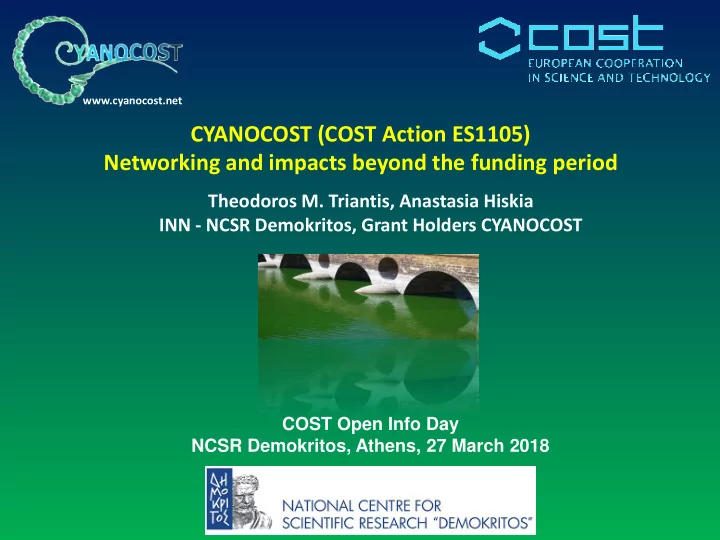

www.cyanocost.net CYANOCOST (COST Action ES1105) Networking and impacts beyond the funding period Theodoros M. Triantis, Anastasia Hiskia INN - NCSR Demokritos, Grant Holders CYANOCOST COST Open Info Day NCSR Demokritos, Athens, 27 March 2018
Scientific context & objectives Cyanobacteria • Photosynthetic microorganisms globally distributed in biosphere • can form blooms and mats (scums) in surface waters. • some species produce toxins, called cyanotoxins . Toxic blooms • human and animal injuries and deaths worldwide • number of societal and economical impacts The main objective of CYANOCOST ( ES 1105 COST Action MoU) to increase, disseminate and harmonize capabilities across Europe for the risk management of cyanobacteria and cyanotoxins in water bodies, by establishing strong and synergistic links between academia, authorities, industry and citizens” Dissemination of more than 25 years’ worth of relevant research. Strong societal and economic impact: Public health, drinking water utilities, aquaculture, recreational activities, tourism.
Worldwide occurrence of toxic cyano-blooms Sulejow reservoir, Poland St. John’s river system, FL, USA Balgavies Loch, Dundee, Scotland Satellite sensing of harmful algal blooms in Lake Taihu, China. Cyanobacterial bloom in Lake Erie (satellite image, Sept. 27 2011) - Increased occurrence of blooms could be associated to climate change . - Invasive species and emerging cyanotoxins are further risks under consideration.
Relevance and impacts of toxic cyanobacterial blooms Human and animal health Aquaculture – Acute poisoning, chronic Ecosystems effects Fisheries Degradation, Loss of Loss of production diversity Cyanotoxins, off-odours Water treatment Tourism Impacts Closures of recreational Costs for treatment sites Cyanotoxins, off-odours
Cyanobacterial blooms and toxins in water resources: Occurrence, impacts and management (CYANOCOST), ES1105 Working groups, Steering Committee Ludek T. Kaloudis Blaha EL CZ Action Chairs Jussi Meriluoto Kaarina Sivonen FI FI Antonio Quesada Luc Brient ES FR Petra Visser Anastasia Hiskia Geoffrey Zorica Svircev NL EL Codd RS UK T. Triantis A. Hiskia Action Grant Holders Individual Participants: 220 - Female: 55%, Early Stage Researchers (ESRs): 18% Total number involved in activities: >250
Member and participating countries CYANOCOST Network March 2017 Participating (35) * including USA as International Partner + Russian Federation and Armenia as Near Neighbour Countries Not (yet) in the network
Impact on EU Water Directives (recast of 98/83 EC ; 2000/60 EC) From www.cyanocost.net, February 2018
Impact on implementation of EU Water Directives First comprehensive handbooks with standardized and validated methods. Development of laboratory capabilities and capacities in Europe. Currently work is done within ISO TC to publish new International Standards.
First multi-lake survey in Europe ! Realized by two COST Actions: CYANOCOST and NETLAKE 369 lakes from 26 European countries sampled. About 200 members involved. Organized by B. Ibelings and E. Mantzouki. Mantzouki et al. Toxins (submitted March 2018)
Promoting European research on toxic cyanobacteria
CYANOCOST Publications More than 200 published items (Dec 2017). The list is still being populated. Available at www.cyanocost.net in pdf format with DOI links and as an EndNote library. Currently trying to measure the impact (total citations).
Interventions and consultation during crisis Serbia: The Uzice case In December 2013 there was a widespread bloom of Planktothrix rubescens in lake Vruci which is an artificial water reservoir serving the city of Uzice (ppl. 70.000). A “do not drink” water notice was issued by local authorities. A Conference was organized (Prof. Zorica Svircev) in Belgrade, to raise awareness on toxic cyanobacteria. A book chapter was published on the management of the Uzice incident. Conference organized in Serbia, to raise awareness on toxic cyanobacteria Water tank in Užice . Photo: Milos Cvetkovic
Tackling new problems: The debate over BMAA, an emerging neurotoxin CYANOCOST organized a workshop (E. Faassen, M. Lurling) to test and validate protocols for the analysis of BMAA, that is strongly debated in the literature. Results of the BMAA workshop were published in Marine Drugs.
Support to Early Stage Researchers: STSMs An example of CYANOCOST STSM poster (During 2012-16 total 44 applications received / 37 supported)
CYANOCOST : From a COST Action to a Network of Networks NETLAKE COST Action EUALGAE SETAC COST Action US EPA ISSHA/ICHA Marine & Freshwater WssTP Toxins Network ISO/CEN Committees
CYANOCOST media www.cyanocost.net
Our messages COST Actions: There can be life after funding ! Suggestions to new COST Action proposers: Focus on strong scientific, societal and economic impacts. Target to solid products in order to achieve maximum impacts. Empower, authorize and support active participants (let the bees be). Support ESRs – increase budget for STSMs and training schools. Keep the network open and inclusive. Use the budget wisely and efficiently. Suggestions to COST Association: Consolidation of networking tools in e-COST (virtual meetings, forums, website development and hosting etc). Designation of MC members could involve approval by the Action’s steering group. Further support to IPC participation. Fast-track NNC and IPC participation approval. Develop and implement measures of Actions’ Impact Any ideas to support active COST Actions after the funding is over (e.g. crowdfunding/donations from members and stakeholders).
Acknowledgements Steering Group: Dr. G. Nounesis, President of Dr. Deniz Karaca, Science Ludek Blaha, Luc Brient, NCSR –D Officer Geoffrey Codd, Anastasia Hiskia, Triantafyllos Dr. V. Kilikoglou, Director of Tania Gonzalez-Ovin, Kaloudis, Jussi Meriluoto, INN, NCSR-D Administration Officer Antonio Quesada, Kaarina Sivonen, Zorica Svircev, NCSR-D Special Account Dep. Silvia Alexe, Petra Visser Mrs M. Fontara, Manager Communications Officer Mrs L. Karakosta Members of the Mr. I Papadopoulos Prof. Ioannis Bartzis, Management Country representative for Committee. Environmental Analysis Lab. Greece Participating members. Dr. C. Christophoridis S-K. Zervou, MSc. (www.cyanocost.net) K. Manolidi, MSc .
Recommend
More recommend